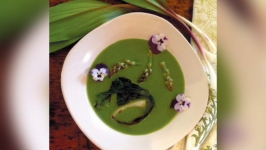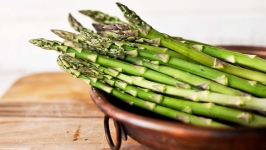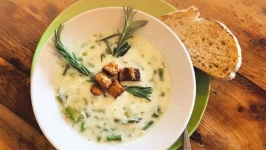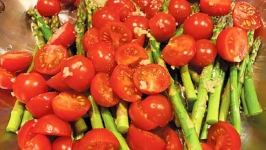The Skinny on Asparagus
Wild asparagus grow pretty much all over the country. You’ll find them along fence lines, ditches, and roads; though avoid roadsides where you suspect there may have been weed spraying. Once you locate a patch you’ll be able to harvest these perennials every year. (It’s easy to locate a patch before everything starts greening up as they stand out from other weeds). The tender shoots or spears come up in the spring, and as the temperature warms, the plant become ferny and bushy, eventually producing little red berries (which are inedible). Wild asparagus can be anywhere from a foot high to as tall as you, and the spears can be stringy and tough, but the flavor! It was wild asparagus that opened my mind to the byproducts that could be made with asparagus.
Cultivated asparagus are sold thick and thin, and vary in color from white to green to purple. White asparagus are blanched by mounding earth around the plant to protect it from the sun. Interestingly, people either seem to love them or hate them. (I love them poached in stock, with sautéed morels on top.) Thick asparagus come from older plants or early harvests, and thin asparagus come from younger plants or later harvests, as the new asparagus shoots become thinner as the season progresses.
I prefer thick asparagus as the texture holds up better under cooking and canning, and I like the purple cultivars the most, as they are especially sweet and tender, though if you pickle them they stain the vinegar purple. It’s okay. Weird, but okay. Look for firm stalks with tight tips. Once the buds start to open the spear quickly becomes woody. Store asparagus in a jar of water in the fridge as you would cut flowers. If you ask me, they’re just as beautiful.
You don’t need to peel asparagus unless the stems are tough, and then, only the lower half of the asparagus. So how much of the spear to use? You can use it all. To trim asparagus, either peel the tough end, and cut off the dry tip, or snap the spears. Hold the ends of the asparagus and gently bend. It will break at the point where the tender part of the asparagus ends. The tougher end of the spear has plenty of flavor, and can be used to make an aromatic stock. You can use the stock many ways: as a soup base (it’s a fabulous base for fish soup), as a poaching liquid for fish, to make risotto and to cook spaghettini.
Cooked with fish or eggs, pickled and used in place of capers in dishes like Chicken Piccata, poached and dressed with homemade mayonnaise, or simply baked and drizzled with oil and Parmesan cheese, asparagus are a real seasonal treat. I pig out on them when they are in, especially in conjunction with other spring foods, like lamb, morel mushrooms, soft shell crabs and vegetable plates with artichokes, peas, and ramps.
SHAVED ASPARAGUS, PEA, & PEA SHOOT SALAD
From The Kitchen Ecosystem by Eugenia Bone (Clarkson Potter, 2014)
Serves 4
I have served this surprisingly rich salad as a second course after a pasta dish, on top of a piece of broiled fi sh, and garnished with croutons: they’re all good! When choosing pea shoots, look for small pale leaves with plenty of thin, curling tendrils. Avoid large stemmy pea shoots, which are tougher. But if you do fi nd them in the market with very long stems you can cut the stems off and throw them in the stockpot. Save the asparagus ends or peels for Asparagus Stock.
Ingredients
- 1½ cups shelled fresh peas (about 1 pound in the shell)
- 12 thick spears asparagus, trimmed (as described in text above)
- 1 large garlic clove, smashed and peeled
- ½ teaspoon mustard powder
- 1 teaspoon fresh lemon juice
- 1 whole anchovy (see Note), chopped
- 2 tablespoons olive oil
- ¼ pound pea shoots
- Salt and freshly ground black pepper
- 1 tablespoon grated
- Parmesan cheese
Instructions
- In a pot of boiling water, cook the peas until tender, about 10 minutes. Drain. Using a very sharp knife (or a mandolin if you have one) cut the asparagus into very thin slivers on an angle. Raw asparagus must be very thinly sliced to be palatable.
- Rub the garlic clove around the inside of a wooden bowl. Add the mustard powder and lemon juice. Mix until the mustard powder dissolves. Add the anchovy and combine well.
- Add the oil, mixing all the while. Add the peas, asparagus, and pea shoots and toss in the dressing. Season with salt and pepper to taste and toss with the Parmesan cheese.
Note: I prefer whole anchovies cured in salt, which you can find in Italian markets. Soak them for 10 minutes to remove the salt, then rinse and fillet them. You don’t have to get all the bones, just the spin.









